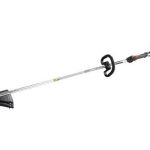If your property has more than its share of trees, then your lawn is going to get a very nice cover of leaves when the fall months come around. Most people use rakes to clear their lawn of leaves. However, there is another alternative to consider –- a leaf blower. A leaf blower is not only ideal for moving leaves; it can also be used to clean your lawn of other debris as well as snow.
Types of Leaf Blowers
There are four types of leaf blowers from which to choose –- electric handheld, gas-powered handheld, gas-powered backpack, and gas-powered wheeled blowers.
Electric handheld leaf blowers include a power cord. They usually weigh about 8 pounds or less and are designed to be used with one hand. They
feature push button starting and there are no exhaust emissions. Moreover, they generate an equivalent amount of power that a handheld gas blower produces. The power cord is only about 100 feet long and needs to be plugged into an electrical outlet. This will no doubt limit your mobility and may cause problems when you’re blowing leaves from under trees and other obstructions. There are cordless electric blowers that are powered with batteries, but they weigh more than the corded blowers. Moreover, batteries periodically need to be recharged. So you may want to have spare batteries on hand if you use a cordless blower. There are cordless electric blowers that feature nickel cadmium or lithium ion batteries. The lithium ion batteries are lighter and smaller than the NiCad variety.
The gas-powered handheld blowers are designed to be used with one hand. Most generate more sweeping and loosening power than electric blowers and most meet noise limitation ordinances although they make more noise than the electric blowers. You yank a pull cord to start the engine and the engine needs periodic tune-ups. You will probably need to wear some kind of hearing protection when operating it. The gas-powered blowers are heavier than electric blowers and weigh about 10 pounds. A 2-stroke engine commonly powers these blowers and requires a mixing of fuel and oil. There are also gas-powered blowers that feature 4-stroke engines, but they are heavier than blowers with 2-stroke engines.
Gas-powered backpack blowers usually offer more power than handheld blowers. Most weigh about 17 pounds or more. Since the blower is actually in a backpack, it is your back and shoulders that carries the weight. This type of blower is also noisier than the electric blower and some may not satisfy local noise ordinances. They can’t vacuum or shred leaves and they usually cost more than handheld blowers.
Gas-powered wheeled blowers provide enough power to sweep a good size area of leaves. They utilize a 4-stroke engine that does not require mixing of fuel and oil. However, these blowers cannot shred or vacuum leaves. They are bulky and weigh about 100 pounds or more. So they are somewhat difficult to handle and need about eight square feet of storage space. Most are noisy and expensive. However, there are a few models that are quiet enough to meet local noise laws.
Available Features
Features that are offered with blowers include the ability to vacuum and mulch. Power output for corded blowers is rated in amps (A); power output for a cordless blower is measured in volts (v); and power output rating for gasoline-powered blowers are in cubic centimeters (cc). Mile per hour (MPH) ratings measures the speed that the air exits the unit and helps to determine the blower’s power. Cubic-feet-per-minutes (CFM) rating measures the volume of air the blower moves. The higher the rating, the more debris the blower can move. Reduction ratios including 10:1 or 16:1 refer to the number of bags of leaves a blower with mulching can reduce to one bag.
Some blowers include larger-diameter chutes or tubes that help collect leaves. Blowers also include speed settings that permit the user to control the airflow and movement of debris. Some blowers feature a fixed setting or variable-speed controls and some let you set and lock the speed. There are also blowers that include a vibration reduction feature.
Things to Consider When Choosing a Blower
Things you need to consider when selecting a blower include:
· The amount of leaves that need to be blown off the lawn. The more leaves you have to contend with, the more powerful blower you should buy.
· You need to be aware of the laws that influence the use of blowers in your neighborhood. There are many areas in the country that have noise ordinances and there are also localities that ban the use of gas-powered blowers.
· Do you need to vacuum? There are blowers that can vacuum up leaves and other debris. However, the tubes used for this feature are limited in how much they can suck up. There are blowers with a metal impeller to perform this task. They are more durable than the tubes over time.
· Flatter nozzles tend to work better for sweeping leaves and rounded nozzles are better for loosening them.
· Adjustable speeds let you reduce power when you’re working around gardens.
· Clear gas tanks are available. They assist in showing the fuel level in the blower.
Finally, there are certain safety precautions you should take when operating a leaf blower.
· Wear hearing protection.
· Wear goggles and a dust mask.
· Keep people and pets away when you’re operating a blower.
· Don’t run a blower during the early morning or late at night.








